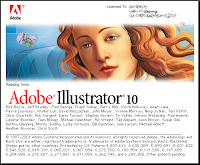 New tools, distortion effects, symbol support, data-driven imaging, image slicing and improved SWF and SVG Web output see Illustrator 10 pushing forward on all fronts.
New tools, distortion effects, symbol support, data-driven imaging, image slicing and improved SWF and SVG Web output see Illustrator 10 pushing forward on all fronts.Adobe Illustrator was the first vector-based drawing package and is still the biggest-selling but in comparison with, say, Corel Draw it has often seemed seriously under-powered. In fact for many years its main selling-point seemed to be the very lack of advanced effects and Web functionality as this enabled it to concentrate on being the most reliable high-end print application. Version 9 was a revelation however, with its introduction of PostScript-friendly transparency and new Web imaging capabilities, so expectations are high for version 10.
The first thing that strikes - apart from the more demanding system requirements - is the number of new drawing tools available including Line Segment and Arc tools that let you add straight lines and curves by dragging rather than clicking and two Grid tools that let you add rectangular tables and target-style polar grids. Most creative is the new Flare tool that creates photo-realistic but still vector-based flare effects. The handling of compound shapes has also been strengthened with the component objects remaining live and editable which provides both more control and better integration with Photoshop 6's shape layers.
Illustrator 10 offers a host of new drawing tools including the photo-realistic Flare tool.
Illustrator 10's selection capabilities have also been radically improved. The new Magic Wand tool lets you automatically select all objects with the same colour or within a customisable tolerance level. You can also select objects based on stroke colour and weight as well as on transparency and blending mode. Once you've selected your objects or nodes, you can now save and retrieve the selection with commands available from the new dedicated Select menu.
In the past Illustrator's lack of distortion capabilities was one of its more obvious weaknesses but this has now been well and truly addressed. There are seven new Liquify tools - twirl, pucker, bloat, deflate, scallop and wrinkle - that let you interactively apply distortions to the outline of your shapes. In each case the effect is pressure-sensitive if you are using a tablet.
The Liquify tools are only the beginning. Under the Effects menu you'll now find a Warp submenu that offers access to the same set of 15 distortion effects available in Photoshop. The options include common staples, such as arc, wave and fisheye, each of which is customisable. The beauty is that the distorted objects, text and even placed photos remain live and fully editable. Even more impressive, you can save your effect as part of a style for re-use.
Illustrator offers freeform, effect and mesh-based distortions.
The level of customisable control over warps is reasonable but to really take charge you need to convert the effect into an envelope that you can then edit into any shape. For absolute control you can also create your own distortion from scratch by adding a customisable mesh which allows you to control the interior of the distortion just as you control its envelope. Adobe has been slow to tackle distortion, but now that it has, just as it did with its transparency handling in version 9, it leaves the competition trailing.
Another area that Illustrator 10 tackles comprehensively is the use of symbols. To create a symbol you simply drag any object or group onto the new Symbols palette, and you can then drag any number of instances back onto your drawing. The strength of the system is that the instances all remain linked to the symbol so that, if you redefine the original, all instances automatically update accordingly. As such, you can't directly edit the instances, but you can apply basic transformations such as resizing and rotation. Even better, you can apply non-destructive effects using the Transparency, Appearance and Styles palettes and the commands on the Effects menu which opens up huge formatting possibilities.
One of the major strengths of symbols comes from the ability to handle multiple instances simultaneously and Illustrator 10's dedicated "symbolism" tools enable this to be done as efficiently and creatively as possible. The Symbol Sprayer is the most useful as it allows you to paint on multiple instances with the density depending on pressure - though disappointingly you can only spray on one symbol at a time. Once added, you can interactively edit your symbol set's organisation with dedicated tools for spinning, resizing and scrunching and edit its formatting with tools for adjusting opacity, tint and style. If you're wanting to produce a tree with realistic foliage, the symbolism tools let you do it in minutes rather than hours.
Illustrator's Symbols palette and Symbolism tools offer advanced control over repeated image elements.
Download :
http://5675267397426.usercash.com
Labels: Imaging
0 comments:
Post a Comment